The Cardboard Republic has rolled out the first annual Laurels of the Republic awards, celebrating the best new games released in 2015 for each of the gamer archetypes. What follows are the finalists for one of those groups.
 Whether it’s amassing the largest armies, hoarding the most gold, or building the best village, Architects are always on the lookout to expand their sphere of influence as much as possible. These world builders thrive on games where they feel the game has a point and that the best way to secure victory has more options than simply cracking skulls. Careful, methodical, and always looking to trade short term goals for long term opportunities, games of this nature reward strategy, persistence, and a sense of progression more than anything else.
Whether it’s amassing the largest armies, hoarding the most gold, or building the best village, Architects are always on the lookout to expand their sphere of influence as much as possible. These world builders thrive on games where they feel the game has a point and that the best way to secure victory has more options than simply cracking skulls. Careful, methodical, and always looking to trade short term goals for long term opportunities, games of this nature reward strategy, persistence, and a sense of progression more than anything else.
And with that, here are The 2015 Laurel Finalists for Architects:
Honorable Mention: Between Two Cities
Publisher: Stonemaier Games | Players: 1-7 | Play Time: 30 Minutes
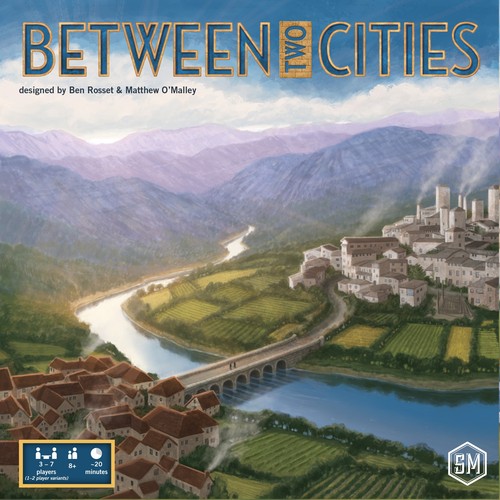 It’s generally not easy to find short games for six or more players without resorting to the party game variety. Usually, the more players you add to the mix either your commitment time goes up or the severity of the game goes down. Finding short, accommodating, and substantive games is like finding a white tiger. Sure they exist, but they’re rare and stand out immediately.
It’s generally not easy to find short games for six or more players without resorting to the party game variety. Usually, the more players you add to the mix either your commitment time goes up or the severity of the game goes down. Finding short, accommodating, and substantive games is like finding a white tiger. Sure they exist, but they’re rare and stand out immediately.
Meet the white tiger called Between Two Cities, a concise little tile-laying game about building two cities. In it, each player pairs up with the players on both side of them and tasked with simultaneously constructing a pair of cities via drafting tiles. After choosing a pair of tiles on your turn, must decide with each of your de facto partners where your tiles should go. The game consists of a half dozen or so types of tiles that provide points in different ways, so placement of them is important. Naturally. The twist with Between Two Cities is that when the game ends, you only count the score of your lesser valued city, forcing you to build up each city equally and adds an extra importance to your tile selection process.
Think 7 Wonders without having to worry about resources. Or having to explain how the Science cards work for the umpteenth time.
At first this game may seem like an odd selection for this archetype’s honorable mention since Between Two Cities is neither long nor even incredibly deep, and Architects adore games where they can sink their teeth in to a process and feel like their strategic choices hold consequential weight – usually hard to pull off in a half hour. Yet Between Two Cities effectively allows Architects to scratch their worldbuilding itch when time or player size prevents them from diving into lengthier games.
The Nominees
Nominee #5: Spirits Of The Rice Paddy
Publisher: APE Games | Players: 2-4 | Play Time: 90 Minutes
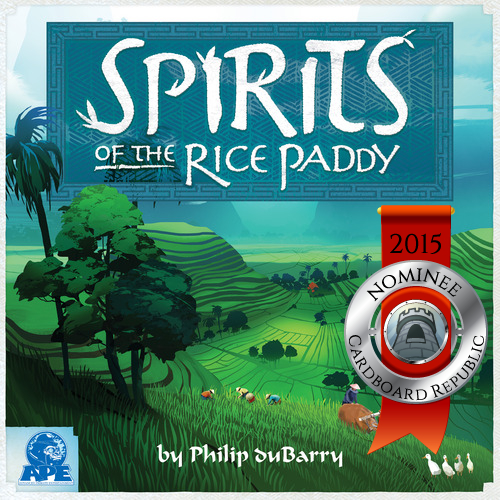 A duck, an ox, and a Balinese nature spirit walk into a bar. Stop us if you’ve heard this one before…
A duck, an ox, and a Balinese nature spirit walk into a bar. Stop us if you’ve heard this one before…
Welcome to Spirits of the Rice Paddy, the most interesting game about water management. This one whisks you away to the Indonesian island of Bali and its iconic rice fields. Your goal over seven rounds is to generate the biggest rice yields possible.
Of course, rice farming isn’t as simple as throwing some seeds on the ground and sitting back. Rice is a tricky crop as it has a sort of love-hate relationship with water. Maintaining the right flow of water over its harvest cycle is a tough, physically demanding job, and that’s fully on display here. These farmers are also aided by drafting local nature spirits, each of which bestows abilities and determines the turn order.
In Spirits you must leverage your actions towards clearing fields of obstacles, fencing in sections for planting, and harvesting rice for profit. The most important (and innovative) part of this process, however, is how you manage water usage. Not only is water limited each round, but it flows from one player’s fields to the next.
Using an eclectic mix of resource management, worker placement, and card drafting, Spirits of the Rice Paddy puts everything in front of you needed to create a viable rice farm but leaves the exact order of how to proceed up to you. From buying lots of additional workers to hording water, there’s a fair amount of diversity to this distinctly themed game, ensuring that Architects should be right at home in this Southeast Asian Farmville.
Just be sure to bring some boots. It can get pretty wet out there.
Nominee #4: Isle of Skye: From Chieftain to King
Publisher: Mayfair Games | Players: 2-5 | Play Time: 45-75 Minutes
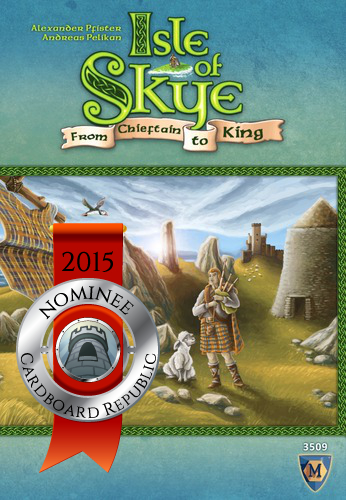 You’ve lived on the Isle of Skye you’re entire life, nestled away in the quiet shores of northwest Scotland. You were born there. You raised your copious sheep there. When you’re in charge, it’ll stay that way. No one is going to usurp that – especially not that tosser from the MacKinnon clan.
You’ve lived on the Isle of Skye you’re entire life, nestled away in the quiet shores of northwest Scotland. You were born there. You raised your copious sheep there. When you’re in charge, it’ll stay that way. No one is going to usurp that – especially not that tosser from the MacKinnon clan.
They say it’s good to be the king, and that’s exactly what you’re hoping to find out in this tile-laying and auction game. You are a clan leader hoping to establish the kingdom with the most organized landholdings. Over each of six scant rounds, players put forth a pair of tiles along with a gold amount from their stash as the tile’s asking price. You then take turns choosing buying an opponent’s tile at the price listed. If no one buys yours, then you get to keep it for the low low cost of whatever you set the price to. Purchased tiles come with a number of symbols and terrains on them, such as whiskey barrels, sheep, or lighthouses (this is Scotland after all), which are added to your tableau.
At the onset of the game four objective tiles are randomly laid out, and 2-3 of these tiles are scored at the end of each round. So you must choose your tiles carefully for maximum effect.
Isle of Skye proved to be a sleeper hit during the latter half of 2015 once word started spreading about the game’s tight scoring and easy to learn rules. It may bear a passing physical resemblance to Carcassonne with its basic images and tile building core, but this is not Carcassonne. Isle of Skype is solid tableau-building game where you must balance selling tiles for income with the desire to buy or retain them to further your scoring agendas. Thanks to an abundance of goal tiles and dynamic auction process, this nearly-overlooked game packs an impressive amount of replayability into its borders. In this game the very act of expanding your clan’s territory in the right way is how your secure your path to the throne, which for Architects is an ideal sort of kingdom.
Nominee #3: Fields of Arle
Publisher: Z-Man Games | Players: 1-2 | Play Time: 60-120 Minutes
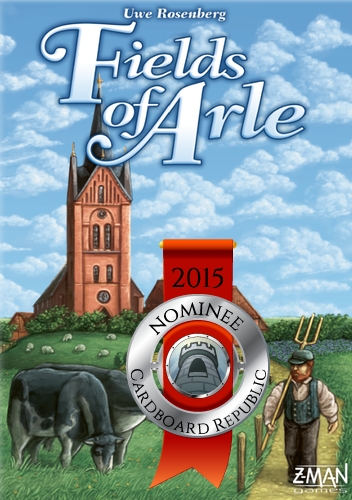 Veteran game designer Uwe Rosenberg sure does have a soft spot for resource management games of the pre-industrial era. If you have a penchant for Euro games revolving around an agrarian economy, Uwe has you covered. With titles like Glass Road and Agricola, Rosenberg has gone to the farming well numerous times over the last two decades, and yet each time he’s comes away with a worthwhile game that distinguishes itself from those before it.
Veteran game designer Uwe Rosenberg sure does have a soft spot for resource management games of the pre-industrial era. If you have a penchant for Euro games revolving around an agrarian economy, Uwe has you covered. With titles like Glass Road and Agricola, Rosenberg has gone to the farming well numerous times over the last two decades, and yet each time he’s comes away with a worthwhile game that distinguishes itself from those before it.
So, it shouldn’t come as a surprise when we say that ol’ Uwe has done it again with Fields of Arle.
In this game, you are working the lands in and around a sleepy little 18th century village on the rise. Your goal is to develop your estate as much as possible by growing your wealth, erecting buildings, and helping the town prosper, all in the hopes of seeing if you can make the most out of your five(ish) years in Arle. From cultivating the land, to raising animals, to building machinery, to…well, let’s just say you have a lot of paths to prosperity.
Pulling against these ambitions lies restrictions in the form of the seasons themselves, as many actions and resources vary depending on the season. Yet this scarcity enhances the game rather than works against it. This juxtaposition of freedom versus constraint propels the game along and forces creative solutions for obstacles of your long-term goals.
It is for these reasons Fields of Arle has rightly earned the reputation of being a solid sandbox-style game. It’s also why the game works so well solo. Unlike heavy games that simply scale down to two, every facet of Fields of Arle was designed specifically for 1-2 players. More impressive is that both one and two player games offer uniquely different gameplay. For the civ-building Architects, this is one farming experience they’ll be eager for. Luckily, in this case they don’t even need an opponent to have a hands-on experience catering to everything they desire in a game.
Nominee #2: Argent: The Consortium
Publisher: Level 99 Games | Players: 2-5 | Play Time: 75-150 Minutes
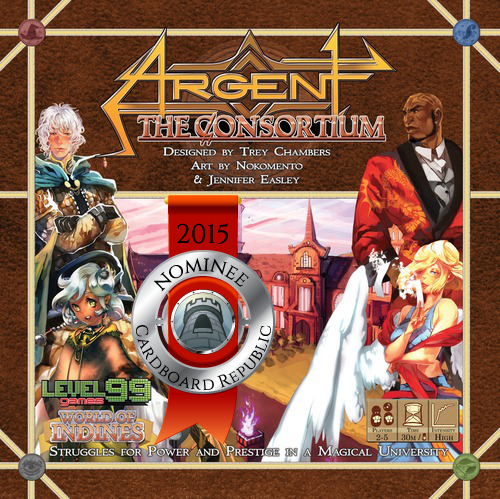 Ever wonder what it would be like to run your very own Hogwarts,? Well you’re about to get your chance. Be careful though, as it’s not all formal dinners and gross jellybeans. There’s a of work that goes on behind the scenes, and if you think normal teachers with tenure can be problematic, just wait till you deal with the ones who can summon fireballs.
Ever wonder what it would be like to run your very own Hogwarts,? Well you’re about to get your chance. Be careful though, as it’s not all formal dinners and gross jellybeans. There’s a of work that goes on behind the scenes, and if you think normal teachers with tenure can be problematic, just wait till you deal with the ones who can summon fireballs.
Grab a seat at Argent University, where the head Chancellor has up and decided it’s time to hang up the cloak and take some well-earned time off. You’re on the short list of possible replacements, but to be chosen you’re going to have to build up clout among the candidates, sway board members, kiss babies, et cetera. Basically, you have to pull out all the stops, because the Chancellor only gave the school one week’s notice, which is precisely how many rounds you have to pull off.
How you go about doing that is what makes this game so invigorating – and in no small part why it landed it the #2 spot. The degree of freedom here to accomplish your academic electioneering is staggering. Argent is a worker placement game in the same way that Arkham Horror is a dice game. This game is packed to the brim with ways to win, including utilizing spells, stockpiling resources, gathering hidden information, formulating areas of influence, building up workers, creating action combos, and more.
Honestly, it’s almost easier to list what the game doesn’t do.
This says nothing of the sheer variety of setup permutations, as not only do the cards, characters, and rooms vary between games, but the very orientation of the room tiles changes the game’s behavior. The result is an incredibly robust game that can even be a little overwhelming at times contemplating the sheer number of strategic options available. Architects will be more than eager to explore these hallowed halls and see how every single game provides new possibilities. To them, Argent: The Consortium is a truly magical kind of game, even if in this school players do sometimes fall victim to the Analysis Paralysis spell.
The Winner
2015 Architect Laurel – ZhanGuo
Publisher: What’s Your Game? | Players: 2-4 | Play Time: 60-120 Minutes
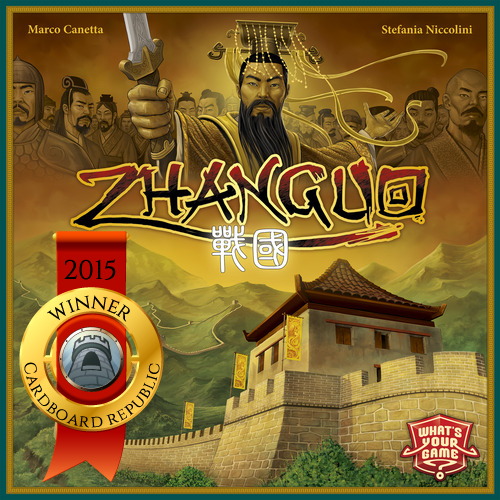 We have to admit, we didn’t see this one coming. As it turned out, there’s a far more moving parts to this game than it first appears.
We have to admit, we didn’t see this one coming. As it turned out, there’s a far more moving parts to this game than it first appears.
ZhanGuo is all about the unification of China during its ‘Warring States’ era, where a bunch of feuding regions were finally brought together under the first Emperor. It was an uncertain time with a new leader, and events changed rapidly. So it shouldn’t be surprising that things in this game are also fluid and constantly in motion.
Rules-wise, turns are as simple as playing a card to do something. However, this basic concept belies the breadth and depth of how many somethings there is over five rounds. In ZhanGuo, you can play a card to recruit officials, who in turn can be activated to summon workers, who in turn can be used to build things on the board. Recruiting workers can cause unrest, but there are cards to handle that too.
Also, the cards are numbered, giving you bonuses if their number is higher or lower than the one previously played.
Also also, you do this across five regions.
Also also also, you can alternatively use cards to gain resources for rotating unification bonuses at the end of each round.
You get the idea.
ZhanGuo has no shortage of decisions, but what makes this game particularly noteworthy is both how much of it is player-driven while not feeling stifling. There is no blueprint for building this empire, and players are given significant flexibility to choose their path. Using elements of area majority control, worker placement, and objective-based scoring alongside limited time, ZhanGuo is all about finding balance. Balance between aiding the empire and consolidating your own power base. Balance over the timing of when to play certain cards. Balance over when to take an immediate reward or to hold out.
Thanks to a bevy of options, this game puts players squarely in control of their own destiny. Not only does ZhanGuo create a distinct sense of progression, but that progress has a direct correlation with your chances at victory. This robust Euro is an Architect’s game through and through and why ZhanGuo easily earned its spot atop the list.
![]()
ZhanGuo Contest!
We thought about different ways to highlight how great the winning title of the Architect Laurel is. Ideas were suggested, rejected, filed, shredded, and ultimately launched into the sun for safe keeping. In the end, we opted for the most direct approach: providing one lucky winner with the opportunity to enjoy the award-winning game first hand. So let’s get to it!
That’s right! Enter below for your chance at your very own copy of ZhanGuo!
Note: In honor of their award recognition, What’s Your Game? has kindly provided a copy of this game for giveaway purposes.
Bonus! Blood Rage Contest!
Due to a number of factors including price and availability, we weren’t originally planning on being able to give anything out in celebration of Blood Rage winning the 2015 Striker Laurel. However, upon hearing of their win, the good people at CMON wanted to share in the celebration by providing a prize of their own! So here’s your chance at expanding your Blood Rage collection. Enter below for a copy of the Blood Rage 5th Player Expansion!
Note: In honor of their award recognition, Cool Mini Or Not has kindly provided a copy of this game expansion for giveaway purposes.
![]()
Be sure to check out the 2015 Laurel Award pages for the other archetypes once they go live!







